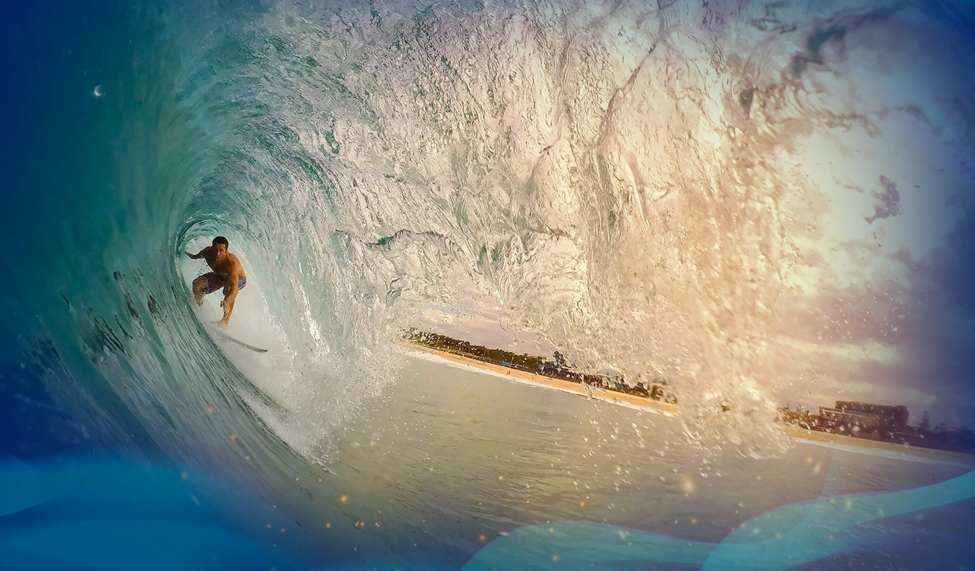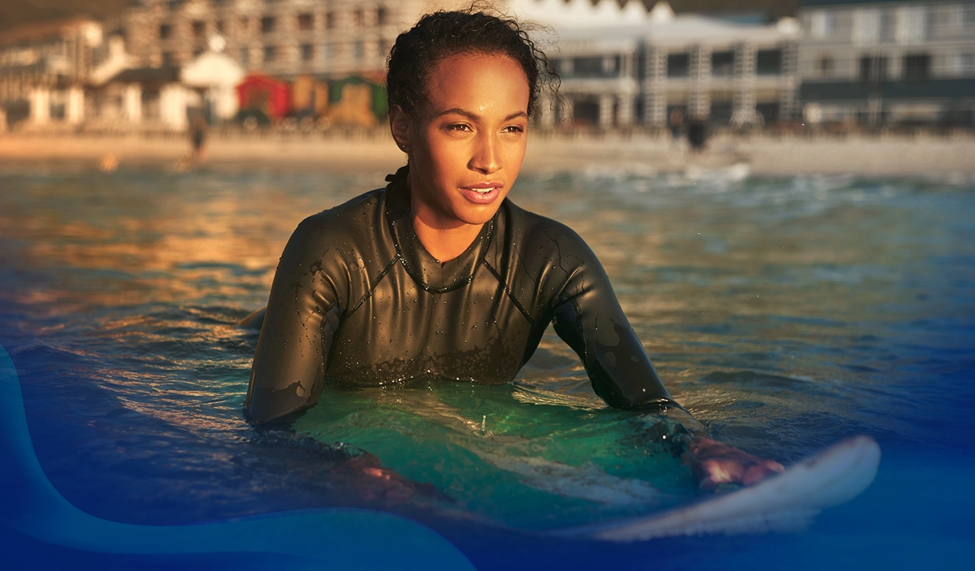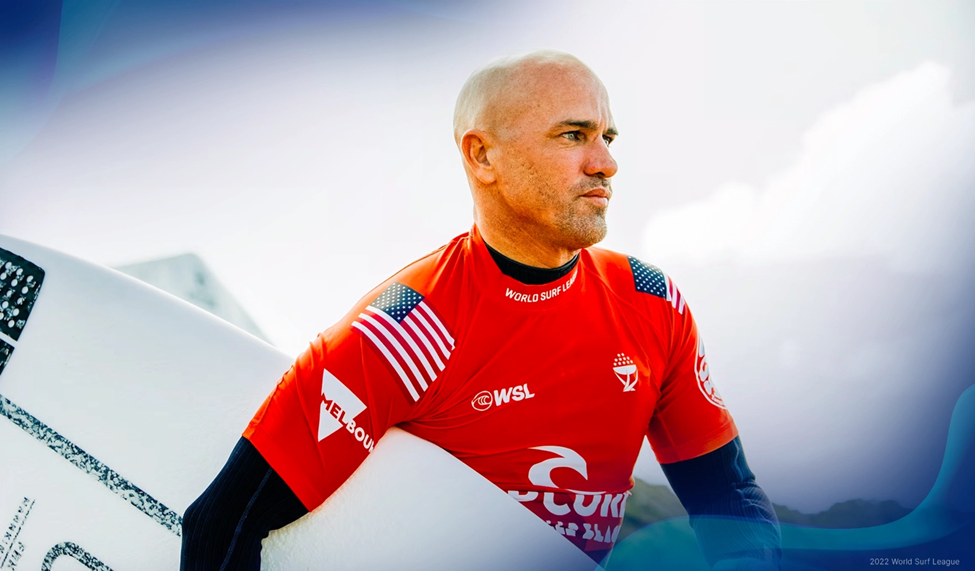
Ask any surfer and they’ll tell you: there’s nothing quite like catching the perfect break. The second you spot the swell. The adrenaline coursing through your veins as you start to paddle. The lift as the water surges behind you. The make-or-break moment you pop up to find your footing. The pure euphoria of gliding across the water and feeling the ocean’s raw power beneath your feet.
If that sounds like something you’d be into, we’ve got the tips you need to make it a reality.
In this guide, we explore the art of surfing, touching on everything from reading waves to picking your perfect board. We also introduce you to some of the biggest legends, competitions, and waves the sport has ever seen.
Breaking Down the Basics: Inside the Fundamentals of Surfing
Whether you’re a newbie or a seasoned wave chaser, it never hurts to visit (or revisit the basics). Here are four of the core skills you need to catch the perfect break.
1. Getting in Touch with the Ocean: Reading Waves
The first step in catching the best break of your life? Understanding the many different types of waves. The more familiar you get with them, the easier you’ll be able to spot and catch them:
- Right wave (rights): A wave that breaks to the right (from the surfer’s perspective facing the shore).
- Left wave (lefts): A wave that breaks to the left (again, from the surfer’s perspective).
- A-Frames: Waves that break both left and right at the same time, creating a peak in the middle. Because you can ride in either direction, A-frames are awesome for beginners.
- Closeouts: Waves that break all at once along the length, rather than peeling to one side. These are not ideal for surfing, as they don’t offer a clean face to ride.
By understanding how each wave behaves, you can predict the best time to paddle, angle your board, and catch the wave as it starts to break.

3. Perfecting Your Positioning
Your positioning can make or break your ride.
For smaller waves or if you’re a beginner, it’s best to sit closer to shore. Here, the waves break earlier and with less power. If you’re a bit more advanced, head a little further out to catch bigger sets. No matter where you are, remember to always face the oncoming waves while staying ready to pivot.
For a successful takeoff, line your board up with the direction of the wave as it begins to rise. Make sure your body is centered on the board, with your chest slightly lifted and your eyes looking forward.
3. Mastering Paddling Techniques
When you’re surfing, you are your own engine. That’s why it’s so important to nail your paddling.
Keep your body in the center of the board, with your chest slightly lifted, your head up, and your feet together. Use long, controlled strokes with your arms, alternating sides. Cup your hands slightly and pull through the water using your shoulders and upper back muscles.
4. Choosing the Right Board for your Skill Level
When you’re starting out, you’ll want to opt for asoft-top longboard. Wide, stable, and typically 8-9 feet long, these boards make it easier to balance and catch small waves. Plus, the soft-top material adds extra buoyancy and safety — perfect for beginners still learning the ropes.
As you get a little more confident, funboards and shortboards offer a new level of speed and maneuverability. Usually 6-8 feet in length, funboards provide more control without sacrificing stability. Shortboards (which are typically under 6 feet) are lighter, faster, and ideal for steeper waves.
Fish boards and gun boards are designed for seasoned surfers and specific conditions. Fish boards are short with wide tails, which makes them perfect for smaller waves. On the other hand, gun boards offer great control in big-wave surfing, thanks to their long and narrow design.
Living Legends: The Icons of the Surf World
Every sport has its stars — and surfing is no exception.
One of the biggest names in surfing is Kelly Slater who is widely seen as the greatest pro surfer of all time. With 11 World Surf League Championships and two gold X-Games medals under his belt, he’s proven himself to be an unstoppable force.
Bethany Hamilton, who bravely returned to the water after losing her arm in a shark attack, inspires many with her tenacity and dedication. Her childhood best friend, Alana Blanchard, is a fellow professional surfer. Blanchard holds a variety of wins in competitions like the T&C Women’s Pipeline Championships and the Rip Curl Girls Festival Junior Pro.
John John Florence is another standout, having earned two back-to-back World Championships in 2016 and 2017.

The World’s Most Famous Surf Competitions
Some of the biggest surf competitions in the world include the World Surf League Championship Tour, Pipeline Masters, and Red Bull Magnitude.
The most prestigious competition in surfing, the Championship Tour attracts the world’s top surfers. Together, they compete for the title of World Champion and a first-place cash prize of $100,000.
Held annually at the Banzai Pipeline in Hawaii, the Pipeline Masters is known renowned for its powerful, top-to-bottom barrels. These waves also come super close to shore, making them ideal for spectators watching from the beach.
Red Bull is no stranger to the world of extreme sports, which is why it’s no surprise it hosts its own surf competition. Red Bull Magnitude platforms 24 of the best big-wave female surfers from around the world. The winner walks away with not only a championship title but a cool $20,000.
The Most Challenging Waves Around The World
It’s safe to say that not all waves are created equal. But a few of them stand out as the toughest to conquer.
As we said before, the Banzai Pipeline is infamous for its powerful barrels and heavy breaks. Epic but dangerous, one wrong move here could be disastrous — which is why it’s reserved for the world’s most skilled surfers.
Teahupo’o in Tahiti is another beast, known for its thick, fast-breaking waves. As if it was legendary enough already, Teahupo’o was hand-picked as the venue for the 2024 Paris Olympic Games’ surf competition.
Mavericks in California features huge swells that can exceed 25 feet. Because they’re so huge, powerful, and unpredictable, bravery and precision are non-negotiables when tackling these waves.
Ready to Catch Your Next Wave?
Each time you paddle out to sea, every wave is a new chance for you to learn and grow. Whether you’re just getting started or refining your skills, the tips from this guide will help you take your surfing experience to the next level.
For an extra dose of inspiration, dive into one of the newest episodes of the Team Ignition Show, featuring an in-depth interview with pro surfer Alana Blanchard. Inspired by her insights and experiences, you’ll be grabbing your board and catching your next wave in no time.



